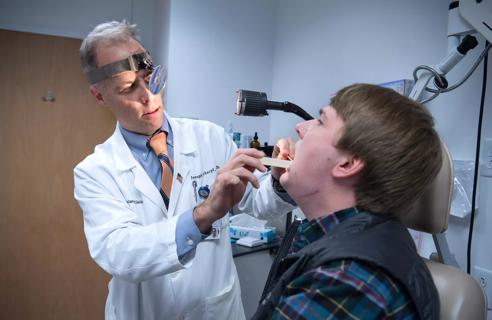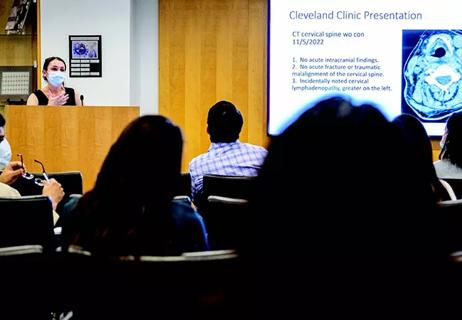Continuous Improvement model makes success repeatable

In 2016, audiologist Sarah Sydlowski, AuD, PhD, MBA, and her team in the Hearing Implant Program at Cleveland Clinic wanted to figure out why so few patients who were eligible to receive cochlear implants were receiving them. At the time, fewer than 10% of people nationally who qualified for the implants actually got them. Cleveland Clinic’s numbers hovered in that range as well.
Advertisement
Cleveland Clinic is a non-profit academic medical center. Advertising on our site helps support our mission. We do not endorse non-Cleveland Clinic products or services. Policy
That was not acceptable. So Dr. Sydlowski tapped the health system’s Continuous Improvement Department and received guidance through a 12-week problem-solving tool called SolVE (Solutions for Value Enhancement). Within a few months of implementation of the plan that came out of that process, implant consultations were on the rise. The trajectory has continued to climb ever since.
The success was gratifying. The deeper revelation was about the problem-solving system itself, she says.
“I’ve always had an inclination to do things better, to grow the program and make sure we are the best we can be. But I didn’t always have the right tools, and I didn’t understand how to pull a team together in that way,” says Dr. Sydlowski. “The biggest takeaway from SolVE was that there is a scientific methodology we could use to solve our problems effectively. It got amazing results and energized the team.”
That experience changed Dr. Sydlowski’s career. Today, she is Cleveland Clinic’s Associate Chief Improvement Officer. There she works with Cleveland Clinic Chief Improvement Officer Lisa Yerian, MD.
Like Dr. Sydlowski, Dr. Yerian’s passion for nurturing Cleveland Clinic’s culture of continuous improvement is rooted in the enthusiasm she sees among teams who are empowered not simply to address a given challenge, but to tackle new ones.
“We help groups build their capabilities by helping them solve their actual problems,” says Dr. Yerian. “That makes them excited, because when they see their impact, they begin to realize what they’re truly capable of. In many cases, that goes well beyond what they ever believed, and then they want to do it again. And that creates the pull for more capability, and more improvement. They want to solve ALL the problems they face! They want to make things better for our patients, and for each other.”
Advertisement
Problem solving — defined in this context as “improving what matters most” — is one of the four systems that comprise the Cleveland Clinic Improvement Model. The others are:
Each of these systems has been used across Cleveland Clinic since 2013, when the Cleveland Clinic CI department began to build a Culture of Improvement – every caregiver capable, empowered and expected to make improvements every day . Over the last five years alone, says Dr. Yerian, the organization has driven over $139 million worth of impact through the work of more than 43,000 Cleveland Clinic caregivers who have engaged in CI and completed over 15,000 improvement efforts.
In the earliest years of CI at Cleveland Clinic, says Dr. Yerian, the department’s efforts were primarily project based.
“We described our team as paratroopers. Expert process-improvement people would paratroop into an area or team and work on a project. We’d make some changes and demonstrate impact, but then we would leave, and the team would have to sustain things on their own,” says Dr. Yerian. “But the world changes, and your process needs to continue to evolve to adapt to that. We needed to focus on building the cultures, systems and behaviors in that team to make sure that they could solve the next problem.”
In 2013, the CI problem-solvers used their own tools to figure out how to build a culture of improvement across the health system.
“We actually used an A3, which is our core complex problem-solving tool teams use in SolVE, to work on this problem,” says Dr. Yerian. “We saw a problem insofar as we had a current state and a target state, and they’re not the same thing. How do we understand that gap and begin to close that gap?”
Advertisement
Using this process, the CI team arrived at the hypothesis that a culture of improvement could take hold if they created the capability for change in others. To test this, they partnered with a group in Finance that wanted to improve its own processes.
First, Dr. Yerian decided, she needed to go to gemba.
“Gemba is a Japanese word that means the literal place where the work gets done. By being in gemba, you’re demonstrating respect for the work and the people doing the work rather than operating from a distance, disconnected from the actual situation and the people doing the actual work,” she says. “Gemba is the place to really understand what’s happening – so you can really observe and understand problems. There’s no replacement for being in gemba.”
When Dr. Yerian visited the Finance group, she heard from the caregivers about the problems they faced in doing their work. The team quickly realized the key would be guiding them to work through solutions themselves.
“I fell back to how I learned to practice medicine or to be a surgical pathologist,” she says. “There are some things you are taught, but mostly you learn through doing with guidance, coaching and feedback. I told them their team would teach themselves, and my team would coach them on how to do that.”
The process started with struggles.
“The executive director and I would go down to visit the team every Friday afternoon, and for a while, those visits were hard. We asked the teams to report out – to share progress on their learning and the problems they were working to solve in front of their leaders and their peers. Everyone was uncomfortable. It was challenging and difficult. We were all learning together.,” she says.
Advertisement
“And then one Friday, four or five weeks in, the teams had started to make changes that they had come up with through the problem-solving process,” she says. “They could see the impact, and they were ecstatic. They totally forgot about all their self-consciousness or that they had to stand and talk in front of a team. They were off-the-charts excited.”
For the CI team, the goal was that word would spread and that self-empowered groups driving improvements for patients and caregivers would become a foundation of the Cleveland Clinic continuous improvement culture. While there are always new teams to train, that culture has grown roots.
The most important advice Dr. Yerian offers for leaders at other organizations interested in pursuing continuous improvement strategies is to “start with purpose.”
“Anchor in purpose. Why really do you want to do this?” she says. “This work is really hard, and if you don’t constantly remind yourself and others why you wanted to do it in the first place, it won’t deliver or sustain.”
As for the cochlear implant project, Dr. Sydlowski says guidance from CI was critical to her team’s understanding of the barriers to uptake. They learned that audiologists and ear, nose and throat (ENT) specialists weren’t confident that they should be sending patients to the program.
“They thought that they were referring someone for a cochlear implant instead of just referring them for an evaluation,” says Dr. Sydlowski. “They needed something quick and easy and comfortable that would allow them to identify potential implant candidates without risk and send them to us so we could talk about next steps.”
Advertisement
The simple solution was an overhead transparency that, when placed over a hearing test, had a shaded area indicating results that warranted referral. Every audiologist and ENT specialist in every Cleveland Clinic location received a transparency with instructions.
Later on, the tool would be adjusted and even further simplified. But at the time, it “ignited a fire in our program,” says Dr. Sydlowski. “And since that time, not just because of that one project, but because of many things we’ve done since then, our program has tripled in size.”
“But the most important thing about that story is not even the results, she adds. “It’s really that the process totally changed how our team functions. And ever since then, which is now seven years out, we approach problem solving very differently. All caregivers across the Cleveland Clinic — and across healthcare — have the opportunity to do that.”
Advertisement

Maintaining connections leads to referrals, recruitment and more

A commitment to sharing expertise has fostered a global exchange of ideas

A century-old medical tradition inspired the weekly complex-case reviews in Rheumatology

Medical students will complete five weeks of clinical training

Findings about the tool's utility were presented at the American Society of Nephology’s 2022 Annual Meeting

Embrace coaching and other tips to be a stronger leader

How hospitals can weave ethics into daily nursing practice to strengthen patient-centered care

Strategies for building connections, staying present